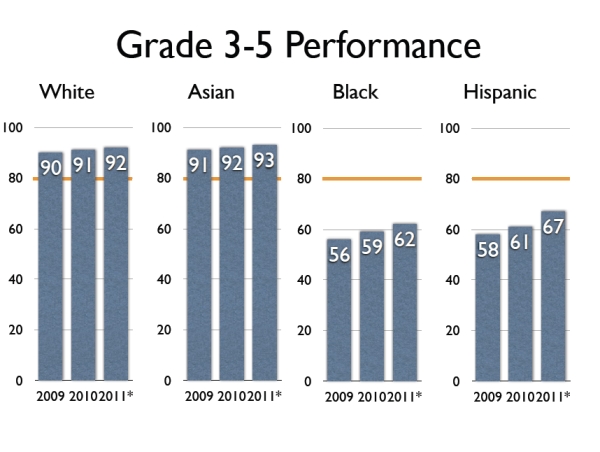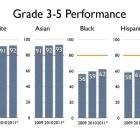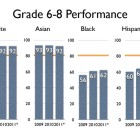The Wake County school system is doing a better job educating almost all of its students.
Testing data released Friday show proficiency gains across major racial and ethnic groups, but African-American and Hispanic students continue to lag behind their white and Asian peers.
“This is certainly not where we want to end up, but I think we’re certainly moving in the right direction,” Superintendent Tony Tata said in a news conference Friday.
Tata presented district-wide percentages of students who passed end-of-grade and end-of-course tests.
All data is preliminary and subject to change pending challenges from schools and final certification by the North Carolina Department of Public Instruction.
Proficiency gaps between white/Asian students and black/Hispanic students ranged up to more than 30 percent in some grade levels. However, proficiency of white and Asian students remains generally flat.
In grades 3 through 5, the proficiency percentage is up three points since 2009, moving from 77 percent to 80 percent. Asian students in these grade levels remain the top performers with 93 percent proficient.
Black students brought up the rear at 62 percent proficient, although they posted larger gains since 2009, rising from 56 percent that year. Hispanic students hit 67 percent proficiency, up 9 percent since 2009.
White and Asian students in grades 6 through 8 tied for first place at 92 percent proficient. Sixty-nine percent of Hispanic students were proficient, a nine-point gain over 2009. Percentages for black students mirrored those from grades 3 through 5, at 62 percent in 2011 over 56 percent in 2009.
Hispanic students made another nine-point jump in high school, from 64 percent proficient in 2009 to 75 percent in 2011. White and Asian students again topped the list with 93 and 92 percent respectively, and black students again trailed all other groups at 67 percent.
The district seems to have curbed the general decline in graduation rates since 2006. The graduation rate in 2011 was 80.4 percent, up from a low of 78.2 percent in 2010 but still down from a high of 82.6 percent in 2006.
As with testing performance, black and Hispanic students fall well short of their white and Asian counterparts. Only 64.7 percent of Hispanic students and 67.2 percent of black students graduated high school this year, compared to 90 percent of Asian students and 90.5 percent of white students.
Tata draws lessons from the data for an approach to student achievement.
“What we have decided is that focusing on the [racial and ethnic] subgroups will get you where you want to be, if you lift up the subgroups,” he said.
Click to view full image.
Change in AYP
Some Wake elementary and middle schools formerly deemed good performers could find themselves considered lacking this year. That’s because the measure of adequate yearly progress (AYP) under the No Child Left Behind Act (NCLB) has risen.
No Child Left Behind, passed in 2001, set 2014 as the year when 100 percent of students around the country should be on grade level as determined by passing state tests. In order to make Adequate Yearly Progress in 2011, schools must post larger percentages of passing students than in 2010.
In grades 3 through 8 math, 88.6 percent of students must pass end-of-grade or end-of-course tests, compared to 77.2 percent last year. The jump in the reading target is even greater, from 43.2 percent in 2010 to 71.6 percent in 2011.
“It’s a tough benchmark to meet,” Tata said. “If this were easy, it would already have been done. It’s a good thing to have standards that are going up.”
Yet the changes mean that even some schools that showed strong growth in the 2010-11 school year may still not make AYP. For instance, Moore Square Middle boasts an 8 percent increase in overall proficiency this year, but the gain would only push the school to 64.4 percent in reading and 73.3 percent in math, well below Adequate Yearly Progress targets.
Other schools made even more impressive gains. River Oaks Middle, a small alternative school for students unable to attend a regular school due to misbehavior or other issues, saw a 14 percent gain in proficiency, while both Wakelon Elementary and Zebulon Elementary rose 13 points.
Tata credited these and other schools’ success to “high expectations and a no-excuses culture” as well as a focus on ensuring that “every child, no matter where they’re at, is taught higher level critical thinking skills.”
He also cited some schools’ implementation of 30 minutes of monitored, independent reading time as key for reading progress in some children who do not come from reading families.


